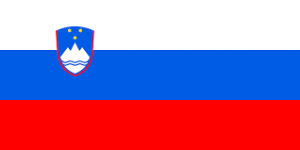Language/Slovenian/Grammar/Conjugation-of-verbs-in-the-present-tense
I am so happy to have you here for another Slovenian language lesson! I am a Slovenian language teacher and I have been teaching Slovenian for 20 years now. In today's lesson, we will learn how to conjugate basic Slovenian verbs in the present tense, including regular and irregular verbs, and their use in everyday conversation.
As a beginner, it can be challenging to conjugate verbs in Slovenian. We have to consider many factors such as the subject of the sentence, the tense, the mood and the aspect of the verb. But don't worry, we'll take it step by step and make it as easy as possible for you!
Conjugation in Slovenian
Conjugation refers to the way we change verbs to match the tense and subject of the sentence. In Slovenian, we have three main groups of verbs: the first conjugation, the second conjugation, and the third conjugation. The conjugation group of a verb can usually be recognized by its ending. However, there are some irregular verbs that do not follow this rule, and their conjugation must be memorized.
First Conjugation
The first conjugation group refers to verbs that end in -ati. Verbs belonging to this group include pogledati (to look), govoriti (to talk), and poslušati (to listen).
Here is how you can conjugate verbs from the first conjugation in the present tense:
| Slovenian | Pronunciation | English |
|---|---|---|
| jaz gled-am | yaz gled-ahm | I look |
| ti gled-aš | tee gled-ash | you look (singular) |
| on/ona/ono gled-a | on/ona/ono gled-ah | he/she/it looks |
| midva/midve gled-ava | meed-vah/meed-vee gled-ah-vah | we (two) look |
| vidva/vidve gled-ata | veed-vah/veed-vee gled-ah-ta | you (two) look |
| oni/one/on-a gled-ajo | on-ee/oh-neh/oh-nah gled-ah-yo | they look |
Second Conjugation
The second conjugation group refers to verbs that end in -eti. Verbs belonging to this group include jesti (to eat), čakati (to wait), and delati (to work).
Here is how you can conjugate verbs from the second conjugation in the present tense:
| Slovenian | Pronunciation | English |
|---|---|---|
| jaz jem | yaz yem | I eat |
| ti ješ | tee yesh | you eat (singular) |
| on/ona/ono je | on/ona/ono yeh | he/she/it eats |
| midva/midve jed-eva | meed-vah/meed-vee yeh-d-eh-vah | we (two) eat |
| vidva/vidve jed-eta | veed-vah/veed-vee yeh-d-eh-ta | you (two) eat |
| oni/one/on-a jed-o | on-ee/oh-neh/oh-nah yeh-d-oh | they eat |
Third Conjugation
The third conjugation group refers to verbs that end in -iti. Verbs belonging to this group include kupiti (to buy), priti (to come), and čistiti (to clean).
Here is how you can conjugate verbs from the third conjugation in the present tense:
| Slovenian | Pronunciation | English |
|---|---|---|
| jaz kup-ujem | yaz koo-poo-yem | I buy |
| ti kup-uješ | tee koo-poo-yesh | you buy (singular) |
| on/ona/ono kup-uje | on/ona/ono koo-poo-yeh | he/she/it buys |
| midva/midve kup-ujeva | meed-vah/meed-vee koo-poo-yeh-vah | we (two) buy |
| vidva/vidve kup-ujeta | veed-vah/veed-vee koo-poo-yeh-ta | you (two) buy |
| oni/one/on-a kup-ujejo | on-ee/oh-neh/oh-nah koo-poo-yeh-yo | they buy |
Irregular Verbs in the Present Tense
Unfortunately, not all verbs in Slovenian are regular or predictable. Some of them have irregular conjugations that must be memorized. Here are some of the most common irregular verbs in Slovenian and their conjugations in the present tense:
| Slovenian | Pronunciation | English |
|---|---|---|
| biti | bee-tee | to be |
| imeti | ee-meh-tee | to have |
| narediti | nah-reh-dee-tee | to do, to make |
| videti | vee-deh-tee | to see |
| morati | mo-ra-tee | to have to, must |
Using Verbs in Everyday Conversation
Learning how to correctly conjugate verbs is an important step, but it's not enough to make you fluent in Slovenian. In order to use verbs correctly in everyday conversation, you also need to learn about their correct usage, such as word order or different grammatical structures.
Word Order in Slovenian
The word order in Slovenian is typically subject-verb-object. However, the object can sometimes come before the verb for emphasis or stylistic reasons. For example:
- Jaz gledam film. (I am watching a movie.) - Film gledam jaz. (I am watching a movie.) [emphasizing "I"]
Auxiliary Verbs in Slovenian
In Slovenian, just like in English, auxiliary verbs are used to construct different grammatical structures, such as the passive voice or the conditional mood. The most common auxiliary verbs in Slovenian are biti (to be), imeti (to have), and hteti (to want). For example:
- Bil sem. (I was.) - Imel sem. (I had.) - Rad bi jedel. (I would like to eat.)
Negation in Slovenian
Negation in Slovenian is formed by adding ne before the verb, similar to the English "not". For example:
- Ne maram kave. (I don't like coffee.) - Ne pišem pisma. (I'm not writing a letter.)
That's it for today's lesson! We covered a lot of ground, but I hope you feel more confident about conjugating verbs in Slovenian now. Don't forget to practice regularly, especially with native speakers or through media such as films, books, and music. See you in the next lesson!
Related Lessons
- Conditional and future tense
- 0 to A1 Course
- Active and passive voice
- Adverbs and prepositions
- Give your Opinion
- Nouns
- Gender
- Adjectives
- Pronouns
- Pronouns and their use

